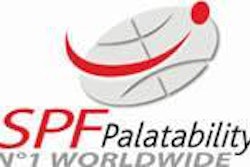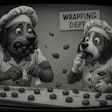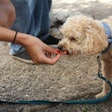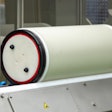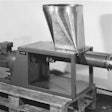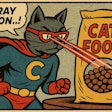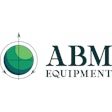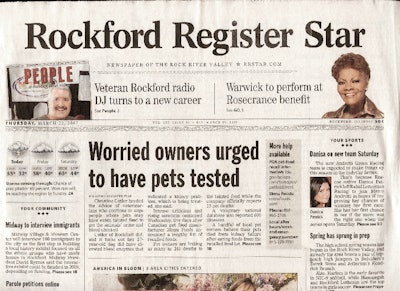
I know how I would feel if my dog died from eating contaminated petfood. I'd be sad, angry and looking for ways to prevent such a thing from happening again. That is how a lot of pet owners are now. Beyond that it's a media and litigation circus.
Fast-breaking news, some inaccurate, from thousands of sources has a huge downside: Brand equity that has taken years to establish can be wiped out in a few days. There are a number of quality assurance systems you can put in place to prevent such devastation. Many petfood companies will likely work at improving vendor certification programs. Still, what if it happens? How do you respond? When something goes terribly wrong, you best be prepared.
Exhibit A: Menu Foods
On March 16, 2007, Menu Foods announced a precautionary dog and cat food recall. (The Menu recall list is available at www.menufoods.com.) On March 23, the New York State Department of Agriculture said it had found the toxin aminopterin in Menu petfoods. But, other scientists were unable to validate the findings.
On March 30, the US Food and Drug Administration (FDA) revealed that a compound called melamine may have caused the pet illnesses and deaths. However, from what experts know about melamine and its effects after being ingested, pets shouldn't have died as a result. While melamine, used as a fertilizer in Asia, should certainly not be in petfoods, it's not known to be lethal. Why, then, have pets died after eating contaminated food? At press time we do not know. Says Dr. Richard Goldstein, an internal medicine specialist and assistant professor at Cornell University College of Veterinary Medicine in Ithaca, New York, USA, "We're missing a piece of the puzzle."
Melamine was found in the wheat gluten from a new Menu supplier in the US, Las Vegas-based ChemNutra Inc., who sourced the wheat gluten in China. This is the same ingredient that Menu Foods made reference to in its recall press release of March 16. Melamine has not been found in the wheat gluten that Menu obtains from other suppliers. The FDA is blocking imports of wheat gluten from a company in China: Xuzhou Anying Biologic Technology Development Co. in Wangdien.
On April 19, the FDA confirmed melamine has been found in wheat gluten, rice protein concentrate and, in South Africa, corn gluten, all imported from China. It now appears likely the melamine was added intentionally to boost the products' protein assays, giving the illusion of a higher protein content.
In fairness to Menu Foods, note that the FDA acknowledged that the adulteration with melamine could not have been identified by detection methods used by the industry and that no violations by Menu Foods have been found.
With all of Menu's quality assurance systems, how did this happen? It is because one supplier's product was adulterated with a material that is not part of any known screening procedure for wheat gluten.
More companies have since recalled specific products, including Nestlé Purina, Del Monte, Hill's, Sunshine Mills, Natural Balance and Royal Canin. Now scientists have found melamine in wet and dry products.
What's next?
What's next remains to be seen. At press time, it is clear that this disaster is not over. Ed Mareth of 3D Corporate Solutions asserts there are monumental changes coming to the way the food chain is regulated, especially the animal food industry (Petfood Forum 2005 Proceedings). He predicts that it is only a matter of time before the media takes an interest in what is entering the grocery store, home and cupboard via the petfood industry. He says, "The best ingredients today are human quality.' You may not like it, but the only way to guarantee safe, consistent and quality ingredients is to buy 'human-quality' raw materials."
Enter the lawyers
Distraught pet owners have filed class-action lawsuits against Menu Foods, as well as against Petco and a manufacturer who used Menu to make its products.
The petfood recall highlights two risks faced by firms using contract manufacturers, concludes The Economist . One is a damaged reputation. Many pet owners have expressed surprise that premium brands were being made with common ingredients and at the same facility as a host of cheaper, own-label brands. Why pay more for branded goods, they ask? The criticism is somewhat unfair: differences between products lie largely in the varying proportions of ingredients used, but the perception of reduced value will be hard to shake. The lessons learned from Johnson and Johnson's handling of the cyanide tampering of Tylenol in 1982 (see sidebar above) may help reduce the damage.
The second risk relates to extended supply chains. The wheat gluten at the center of the contamination investigation was imported from China. Things can go wrong at companies' own facilities, but the recall will likely prompt tougher provisions in agreements with contract manufacturers. Some companies will stop using contract manufacturers entirely. For example, Natura Pet Products of San Jose, California, USA, has pledged to either acquire or build a canning plant so that the company can exercise complete control over its product lines.
Traceability is a must
The Menu petfood recall has created a heightened awareness of petfood safety and traceability issues. Traceability is the ability to trace and follow a food, petfood, feed, food-producing animal or substance through all stages of production and distribution. From core genetics to the petfood bowl, tracing involves identifying and documenting all procedures and practices that impact the life of a given product and making this information available to the purchaser or any other supply chain participant. Relatively new FDA regulations, namely those stemming from the Bioterrorism Preparedness Act of 2002 (www.fda.gov/oc/bioterrorism/bioact.html), make traceability a must, contends traceability expert Julie L. Kirk.
In these recent FDA regulations, the primary role of traceability is to protect public health and animal health by facilitating the rapid withdrawal of products from sale and minimize potential impacts of bioterrorism. The drive for traceability in food and petfood manufacturing has been accelerating outside the US and is quickly becoming a US requirement.
A firm handshake and a solemn pledge to deliver safe petfood is no longer enough. More and more, major customers such as Wal-Mart are saying, "No data, no sale." Petfood companies that lack data transparency and detail will find it increasingly difficult to compete in the global market.


